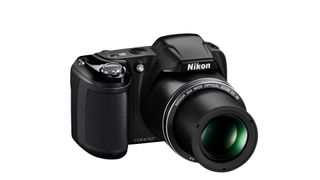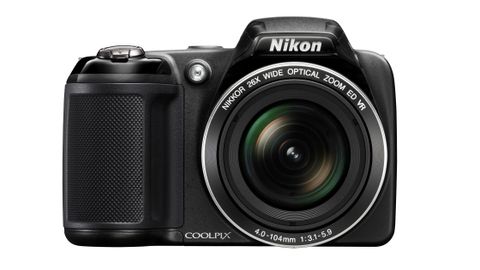Why you can trust TechRadar
Shots taken with the Coolpix L330 generally turned out to be evenly exposed, with fine detail captured well and with very little distortion or camera shake, even at the far end of the optical zoom. I was particularly pleased with the punchy, bright colors that it produced.
Sensitivity on the L330 is set by the camera for all modes except Auto Mode, where you can select from ISO 80 - 1600 or let the L330 pick the right sensitivity for you, and while shooting outdoors I found it generally produced little to no noise until the sensitivity was set to ISO400 and above, even on overcast days. There is a little noise seen at ISO400 and above, but it's nothing unexpected for a camera of this quality. Shooting indoors, however, produced a fair bit of noise in lower light conditions, and images above ISO400 are disappointingly grainy.

While there is a custom white balance mode available on the Coolpix L330 when shooting in Auto Mode, I found that it produced inconsistent results - sometimes it added a blue color cast to shots even after taking a custom reading. The auto white balance setting did a great job of producing accurate colours, while the presets are a good option if you're finding that the automatic setting is erring slightly.
It's not possible to adjust the autofocus or the metering mode which is a shame, as the L330 sometimes overexposes a shot if there is a wide expanse of light which might have been fixed with a different metering method.
In general however most photos are well balanced, whether using the easy auto mode or using the specific scene modes. Autofocus is quick to find a subject and generally seems to focus correctly, although it sometimes struggles to pick up smaller items in the foreground while using the optical zoom.
There are five color modes available and they all produce decent images - I was especially happy with the results from the Black and White filter which leant a moody and dramatic feel to the final shots, and the Vivid Color filter was useful for pushing up the saturation when required. While some of the filters might not be to everyone's tastes, it's worth experimenting to see if you like them.
There is a little fringing to be seen when shots are zoomed to 100%, but it's unlikely to be something you'd notice when printing at A4 or below, and isn't particularly surprising for a budget camera.
Lens performance
Zoom performance on the L330 is very impressive, there is no doubt about it. I was also impressed with the Vibration Reduction technology - even at the highest optical zoom the view on the screen was steady. It's a neat lens, allowing users to focus on far away scenes with very little noticeable loss of quality.
I was also impressed with the macro performance from the L330. The detail it can capture is great and the claims that it can focus from 1cm are spot on - although sometimes the shadow of the camera can be a hindrance when shooting that close to your subject in direct light. Using the Close Up scene mode produces fantastic results that are hard to fault.
Panoramic Assist is offered in lieu of a dedicated panoramic scene mode, meaning the Coolpix L330 will assist you in lining up your photos but you'll have to stitch them together using your own software once you've downloaded them, which is a bit of a shame.
In an upgrade from the 230k-dot screen of the L320, the 460k-dot 3" LCD screen is sharp and crisp, but while it should cope well in bright sunlight due to its anti-reflection coating, in reality it is plagued by pink lines whenever it's directed at a light source. These don't appear on the final images but could confuse some users, especially the beginner users this camera is aimed at.
Video
Video performance from the Coolpix L330 is reasonable, although not particularly sharp and the noise from using the zoom is very audible during playback. It does, however, manage to autofocus well while zooming in and out, which is nice to see.
I used alkaline AA batteries during testing, and was pleasantly surprised with the outcome - the battery indicator was still full after a couple of hours of near constant shooting (including using the flash and recording a few minutes of HD video), and I managed to take 400-500 photos before performance started to suffer with slower shot processing times.
While AA batteries are useful if you want to travel, or don't want to worry about running out of charge, I'd still like to see a lithium ion battery with this camera, as AA batteries can become expensive to replace and can become sluggish when they're low on charge. However, users should at least be able to get a fair amount of shots from the L330 before they experience slower shot processing times or have to change the batteries.
Verdict
Frustratingly low on basic manual settings like the ability to adjust the metering mode, the L330 has been designed for users who want to snap and go, and not mess around with settings. Sadly, this means that when the exposure or the metering decided by the Auto Mode isn't quite right, there's little you can do to adjust the scene and try again, which some users may find annoying.
It's not all bad - the Coolpix does, for the most part, work well and provides users with an easy to use camera with a decent battery life (based on use of alkaline AA batteries) and a great zoom lens. If you're also interested in taking macro photos then the L330 is certainly one to consider as the results were consistent and impressive.
For only a bit more money you can pick up the Canon Powershot SX510 HS, which has full manual control, full HD, Wi-Fi, GPS and 30x optical zoom, and while it only has a 12 million pixel sensor this doesn't necessary mean a lack of quality. It also has a rechargeable lithium ion battery, which may appeal more to some users.
Alternatively, the Sony DSC H300 has a 20 million pixel sensor and 36x optical zoom and uses AA batteries - both alternatives are available for around £30 more than the L330 but offer a lot more desirable options for the average user.
We liked
If you're interested in a long zoom or macro photography then the Coolpix L330 can and will produce consistent results for you, no matter what the subject. It's super easy to use and the battery life is pretty decent for AA batteries.
We disliked
This camera is basic and it feels like Nikon missed a trick - if there were just a few more options it would appeal to a far broader audience. As it is, people who are already comfortable using a digital camera might be put off by the lack of settings available, while beginners may not appreciate the chunky shape.
Final verdict
Although the performance from the L330 is good, there are a few annoying niggles that stop us from loving this camera. The lack of settings and the slow response when the batteries start to fail all became irritating with prolonged use.
For users just starting out with photography and want a larger zoom than most compacts can provide them the Coolpix L330 is a safe bet, but for the more experienced crowd, or those who would like to experiment more with their photography this probably isn't the camera for them.
Current page: Performance and verdict
Prev Page Overview, performance and handling Next Page Sample images
